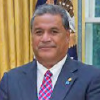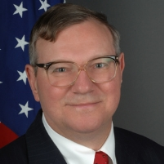Micronesia
 Susaia, Akillino
Susaia, Akillino
Akillino Harris Susaia, a long-time government official in the Federated States of Micronesia (FSM), was confirmed as his country’s ambassador to the United States in December 2016. He presented his credentials to President Donald Trump on April 24, 2017.
Susaia is no stranger to the United States. After graduating from Xavier High School in Chuuk (or Truk) in 1976, he attended Kapiolani Community College in Honolulu, the University of Hawaii-Manoa, as well as the University of the South Pacific in Fiji before coming to the University of Oregon. There, Susaia earned a B.A. in political science in 1990 and an M.A. in public administration in 1993.
Even before completing his schooling, however, Susaia was working as a legislative aide in the Pohnpei state legislature from 1978 to 1988 and a budget officer for the legislature from 1988 to 1996. He then took over as general manager of the Pohnpei Port Authority.
In 2003, Susaia was named secretary of the Department of Transportation, Communication and Infrastructure and in 2005 moved over to the Department of Economic Affairs as secretary. He returned to Hawaii in April 2008 to serve as consul general, representing the interests of the large number of Micronesians who lived there, thanks to their status under the Compact of Free Association between FSM and the United States. FSM citizens may move freely to the United States without a visa.
Susaia was sworn in as the first FSM resident ambassador to China on March 26, 2010, with additional responsibility for Thailand, Vietnam and, in 2013, South Korea. He served in Beijing until 2015, when he ran an unsuccessful campaign for governor of Pohnpei, losing to Marcelo Peterson 53%-47%.
Susaia and his wife, Mihpel, have four children: Ricky, Clara Ann, Einstein and Shalene Rose.
-Steve Straehley
To Learn More:
Remarks by Akillino Susaia at Presentation of Credentials
Congress Confirms Susaia for Ambassador and Hainrick for Auditor (Yap Congressional Delegation Office)
Akillino H. Susaia (Facebook)
- Table of Contents
- News
- Overview
- Basic Information
- History
- Newspapers
- History of U.S. Relations with Micronesia
- Current U.S. Relations with Micronesia
- Where Does the Money Flow
- Controversies
- Human Rights
- Debate
- Past Ambassadors
- Ambassador to the U.S.
- Embassy Web Site in the U.S.
- Comments
- Leave a comment
U.S. Ambassador to Micronesia

The Pacific island nation of Micronesia will soon have its eighth U.S. ambassador, a career Foreign Service Officer who will be serving her first ambassadorship. Dorothea-Maria (Doria) Rosen was nominated by President Obama on March 9, 2012, subject to Senate confirmation. This country of tiny, scattered islands in the Western Pacific used to be a territory of the U.S., which has had an embassy there since September 20, 1989.
Previous U.S. Ambassador to Micronesia

A former Air Force translator, Peter A. Prahar, is the latest ambassador to the Federated States of Micronesia (FSM), a country of tiny, scattered islands in the Western Pacific. In 1983, the US and FSM governments entered into a status of Free Association, which provides Micronesia with significant financial assistance in exchange for U.S. defense rights in the region. The FSM islands were part of the Trust Territory of the Pacific Islands, established after World War II by the United Nations but administered by the United States beginning in 1947. The FSM consists of four states: Yap, Chuuk, Pohnpei, and Kosrae. These four out of the original seven Trust Territory districts are together for one reason—the U.S. had no plans for military bases in any of them. President Barack Obama nominated Prahar for the post October 9, 2009, and he was confirmed by the Senate November 20.
 Susaia, Akillino
Susaia, Akillino
Akillino Harris Susaia, a long-time government official in the Federated States of Micronesia (FSM), was confirmed as his country’s ambassador to the United States in December 2016. He presented his credentials to President Donald Trump on April 24, 2017.
Susaia is no stranger to the United States. After graduating from Xavier High School in Chuuk (or Truk) in 1976, he attended Kapiolani Community College in Honolulu, the University of Hawaii-Manoa, as well as the University of the South Pacific in Fiji before coming to the University of Oregon. There, Susaia earned a B.A. in political science in 1990 and an M.A. in public administration in 1993.
Even before completing his schooling, however, Susaia was working as a legislative aide in the Pohnpei state legislature from 1978 to 1988 and a budget officer for the legislature from 1988 to 1996. He then took over as general manager of the Pohnpei Port Authority.
In 2003, Susaia was named secretary of the Department of Transportation, Communication and Infrastructure and in 2005 moved over to the Department of Economic Affairs as secretary. He returned to Hawaii in April 2008 to serve as consul general, representing the interests of the large number of Micronesians who lived there, thanks to their status under the Compact of Free Association between FSM and the United States. FSM citizens may move freely to the United States without a visa.
Susaia was sworn in as the first FSM resident ambassador to China on March 26, 2010, with additional responsibility for Thailand, Vietnam and, in 2013, South Korea. He served in Beijing until 2015, when he ran an unsuccessful campaign for governor of Pohnpei, losing to Marcelo Peterson 53%-47%.
Susaia and his wife, Mihpel, have four children: Ricky, Clara Ann, Einstein and Shalene Rose.
-Steve Straehley
To Learn More:
Remarks by Akillino Susaia at Presentation of Credentials
Congress Confirms Susaia for Ambassador and Hainrick for Auditor (Yap Congressional Delegation Office)
Akillino H. Susaia (Facebook)
Comments
U.S. Ambassador to Micronesia

The Pacific island nation of Micronesia will soon have its eighth U.S. ambassador, a career Foreign Service Officer who will be serving her first ambassadorship. Dorothea-Maria (Doria) Rosen was nominated by President Obama on March 9, 2012, subject to Senate confirmation. This country of tiny, scattered islands in the Western Pacific used to be a territory of the U.S., which has had an embassy there since September 20, 1989.
Previous U.S. Ambassador to Micronesia

A former Air Force translator, Peter A. Prahar, is the latest ambassador to the Federated States of Micronesia (FSM), a country of tiny, scattered islands in the Western Pacific. In 1983, the US and FSM governments entered into a status of Free Association, which provides Micronesia with significant financial assistance in exchange for U.S. defense rights in the region. The FSM islands were part of the Trust Territory of the Pacific Islands, established after World War II by the United Nations but administered by the United States beginning in 1947. The FSM consists of four states: Yap, Chuuk, Pohnpei, and Kosrae. These four out of the original seven Trust Territory districts are together for one reason—the U.S. had no plans for military bases in any of them. President Barack Obama nominated Prahar for the post October 9, 2009, and he was confirmed by the Senate November 20.







Comments